We list the top Reggio Emilia schools and programs in Canada. You can also filter these schools in terms of various criteria and compare them in terms of academics and cost. Click on a school profile to learn all about it and decide whether it’s the right fit for your child.
We also provide an introductory discussion of Reggio Emilia education. This discussion covers a wide range of topics, including the Reggio philosophy, classroom, learning materials, and appeal.
1 | List of Reggio Emilia schools |
|
"SMLS is a premier independent school for girls Junior Kindergarten to Grade 12 since 1891. We give our students the tools to excel in the world—and help shape it.
—From the school
|
|
"Hudson encourages students to do one thing above all else: be yourself. Our down-to-earth community celebrates personal strengths, fosters intellectual curiosity, and encourages ambitious personal goals.
—From the school
|
|
"Kingsway College School's (KCS) goal is to provide environments where a student’s wellness is supported as they become lifelong learners who are good people. Spend an hour at KCS to see how we do this every day.
—From the school
|
|
"Bayview Glen is co-ed, multi-denominational and diverse. Our student, faculty and staff community mirror the diversity of Toronto. Our culture is one of balance and openness, and embraces different perspectives.
—From the school |
|
Winnipeg, Manitoba Langside St./Westminster Ave. "Parents trust us to personalize the educational experience of each girl, to care for each girl, to challenge her to grow, to build a supportive community around her, and, most importantly, to prepare her for the future." —From the school
|
|
Toronto, Ontario Spadina/St Clair Ave W "The Bishop Strachan School is a leading independent JK-Grade 12 day & boarding school for girls. Students build academic skills to thrive at university and beyond. Over $2 million available in financial assistance." —From the school
|
|
Victoria, British Columbia Richmond Rd/McRae Ave "Independent Junior Kindergarten to Grade 12 boarding and day school in Victoria, BC, Canada focusing on outstanding preparation for life. Find out how a SMUS education can benefit your family." —From the school
|
|
Richmond Hill, Ontario "Richland Academy is a progressive, innovative Reggio-inspired and International Baccalaureate (IB) PYP Authorized and MYP Candidate School for children from Junior Kindergarten to Grade 8." —From the school
|
|
Etobicoke, Ontario "Oak Learners inspires meaningful learning every day for students in Kindergarten through Grade Eight. Passionate teachers nurture students' natural curiosity about their world through hands-on experiences and the Arts." —From the school
|
|
Etobicoke, Ontario Lakeshore and/Kipling "Our approach to learning surpasses traditional education outcomes by interweaving subjects for holistic understanding, fostering essential skills for navigating life challenges in social, emotional and academic contexts." —From the school
|
|
Toronto, Ontario Bayview Ave/Broadway Ave "A daily goal is for our children to arrive at school excited for the day ahead. Aside from our excellent academic programs, we plan many fun events for the children to enjoy throughout the school year." —From the school
|
|
Toronto, Ontario Bloor St W/Jane St "SMS champions neurodiverse students with inclusive, enriched education tailored to their strengths. Since 2011, we’ve fostered an environment where ADHD, anxiety, giftedness, and other LDs are understood and celebrated." —From the school
|
|
Winnipeg, Manitoba South Dr/North Dr "SJR is the world’s leading school in Debating and Public Speaking. It has produced 18 Rhodes scholars and 3 math olympiads. 98% of SJR graduates are accepted to their first choice university program." —From the school
|
|
Richmond, British Columbia "We emphasize critical thinking, as well as innovation, joy, and curiosity." —From the school
|
|
Toronto, Ontario Bayview/Eglinton "CGS represents a strong sense of community where we partner with our families and experienced team of educators to promote a balanced academic-and-values based environment; diversity and inclusion are paramount." —From the school
|
|
Etobicoke, Ontario Bloor/Shaver "Kingsley's small classes and personal approach help students reach their unique potential. Each child is seen, heard, and respected. French, music, and phys-ed round out a program which includes plenty of time outdoors." —From the school
|
|
Newmarket, Ontario Mulock Drive/Bayview Avenue "Pickering College's fully-integrated Global Leadership Program (JK to Grade 12) inspires students to become agents of courageous, ethical and positive change with the confidence, knowledge and skills to shape the future." —From the school
|
|
West Vancouver, British Columbia "Collingwood’s personalized and inclusive approach fosters academic excellence and well-being as our students explore opportunities across the four strands--academics, athletics, arts and service learning." —From the school
|
|
Richmond Hill, Ontario Leslie/16th Ave "Morningside/ABA based curriculum and individualized approach targets not only academic success but also emotional, social, vocational and life skills that are the core skills of life-long success of each student." —From the school
|
|
North Vancouver, British Columbia W 22nd/Phillip "As a Reggio Inspired School in North Vancouver, Sunflower engages daily in rigorous reflective practice - collaboratively designing curriculum and environment around the emerging interests and curiosities of the children" —From the school
|
1 | Quick Summary |
Reggio Emilia is a unique approach to early childhood education. Based on the views of Loris Malaguzzi, it’s offered in many preschools worldwide. It’s also offered in some elementary schools.
The Reggio Emilia approach is child-centred. Teachers build on children’s curiosity and competence, and help them to fulfill their vast potential.
The Reggio curriculum is emergent. Teachers don’t pre-plan children’s tasks and activities. Instead, they emerge as a product of children’s interests.
Projects are a major focus in Reggio schools. Children pursue plenty of short- and long-term, open-ended projects suited to their stage of development. These are chosen together by children and teachers.
Reggio classrooms are set up to promote interaction, collaboration, and cooperation. Children often work with small groups of their peers on challenging projects.
Reggio children are encouraged to express themselves in many different ways, using many different media. There’s a special focus on artistic media, such as drawing, painting, modelling, sculpting, music, and dance.
We list private Reggio Emilia schools on this site, and provide tools for comparing those schools. Moreover, our parent discussion forum allows you to discuss options and get answers to your questions.
2 | Reggio Emilia philosophy |
You may be surprised when walking into a Reggio Emilia classroom. What you find may not match the image you have of preschool or kindergarten.
“We have ‘opening circle time’—we sit in the circle and sing songs, and this is the time we’ll plan what we’re going to do for the day,” explains Nadia Nikolov, as she describes a typical morning at Urban Academy’s Reggio Emilia-inspired kindergarten class. “We have two hours of ‘free exploration’, and usually the teacher is sitting close to the kids and taking notes on what’s happening.… During our lunch and prep time, we share our findings, and decide which way we’re going to go after,” Nikolov says. “We just observe the children and go with their interests.”
The Reggio Emilia approach is used in many preschools, daycares, and kindergarten classes. It’s also been adapted for use in some elementary schools.
The approach is named for the village of Reggio Emilia, in Italy. It was developed in the 1940s, shortly after World War II, by several teachers and parents who lived in this village. Most notable among these was Loris Malaguzzi.
“Children, Reggio educators recognize, have a unique nature. They’re competent, curious, and full of knowledge.”
Children, Reggio educators recognize, have a unique nature. They’re competent, curious, and full of knowledge. It’s our duty, they urge, to build children’s strengths, to enable them to realize their vast potential.
This can be achieved partly through the learning environment. By providing a supportive and enriching classroom, we can promote exploration, discovery, and interaction among children. It’s also important, though, to encourage expression. We should encourage children to express themselves in a wide range of ways and using diverse media (such as painting, sculpting, and drama). We should also urge them to share their thoughts and ideas about lots of subjects.
Above all, children should be given the freedom to pursue their interests. With help from their teachers, they should be able to plan their course of study.
“I think something that’s fundamental is that children are the architects and the builders along with their teachers for their experience in school,” say Kerri Embry and Shelley Van Benschop, lead teachers of research and inquiry at The Bishop Strachan School.
Both teachers use the Reggio Emilia approach in their kindergarten classrooms.
“[It’s] seeing the teacher as a researcher, as somebody who doesn’t necessarily know what they’re going to be doing that year. They have goals and outcomes, but they don’t know the path they’re going to take to get there. Things emerge as we go because we’re responsive to the children—we’re listening to the children.”
“Reggio Emilia’s child-focused approach to education is, in many ways, similar to that of Montessori and Waldorf schools.”
This child-focused approach to education is, in many ways, similar to that of Montessori and Waldorf schools (for a comparison of different preschool approaches, see our preschool and comparison guide). Yet, unlike Montessori and Waldorf, Reggio Emilia education is not based on a unified set of principles. Instead, it’s based on certain values about how children best learn.
“These values are interpreted in different schools, different contexts, and different ways,” says Susan Lyon, executive director of the Innovative Teacher Project, which aims to develop and promote Reggio-inspired education.
Moreover, unlike Montessori and Waldorf, Reggio Emilia has no international centres to accredit schools or train teachers. At least outside of the town of Reggio Emilia, all preschools and schools (and home schools) are Reggio-inspired. They use an adaptation of the Reggio approach to meet the needs of their community.
This is important, as each student, teacher, parent, community, and town is different. No two Reggio-inspired schools look the same, as the needs and interests of the children in each community are different.
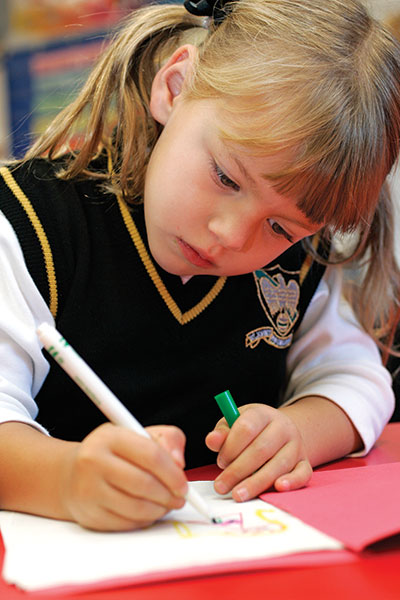
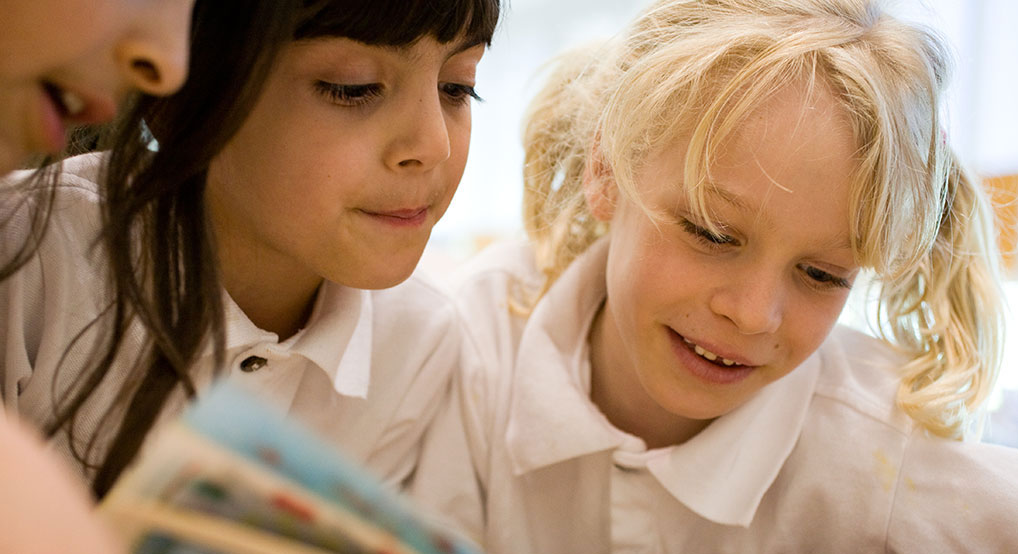
3 | Reggio Emilia classroom policies and practices |
Reggio Emilia is an approach to early childhood education. Yet, as mentioned, the approach is neither universal nor set in stone. Schools adapt it in different ways according to the needs of their children and communities. This means that different schools tend to have different classroom policies and practices.
Nevertheless, there are some core classroom policies that many Reggio-inspired schools employ. We discuss the main ones below.
Multi-age classes
Most Reggio preschools have two classes. Similar to Montessori preschools, these classes have multi-age groupings. Usually, there’s one class from 0 to 3, and another class from 3 to 6. Reggio-inspired elementary schools also tend to have multi-age classes.
These classes usually have two teachers. Children thus typically stay with the same teacher(s) for a three-year period. This leads to consistency in the teaching approach. It also means children won’t have the pressure of forming new relationships each year—with teachers or peers.
Moreover, since teachers stay with the same class for a long time, they get to know children well. They become familiar with each child’s personality and learning style, and often adjust their approach to meet their needs.
To learn more, read our Reggio Emilia preschool guide. You can also read our comparison guides: Reggio Emilia vs. Montessori preschools and Reggio Emilia vs. Waldorf preschools. Finally, check out our guides to preschool in general, different preschool programs, preschool compared to daycare, preschool curriculum, and the pros and cons of preschool.
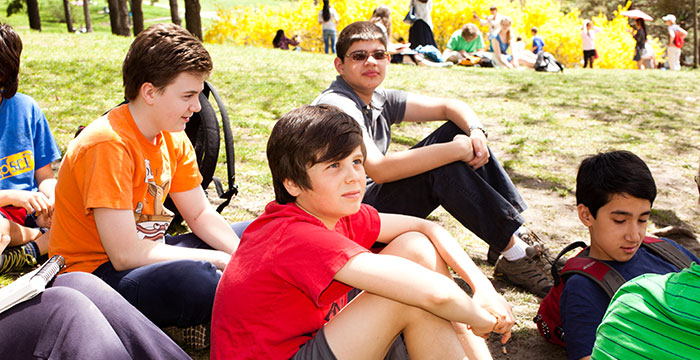
Self-guided curriculum
Reggio-inspired schools have a mostly self-guided curriculum. Teachers listen to and observe children in the classroom to discover what interests and excites them. They also listen to and discuss (with each other and children) children’s ideas for work. They use this knowledge to prepare the learning environment, plan their teaching approach, and plot out the curriculum.
Teachers and children thus co-construct the curriculum. This is sometimes referred to as a “negotiated curriculum.”
That said, there is an age-appropriate curriculum and daily schedule for each class. This ensures children pursue activities suited to their stage of development. This is similar to the Montessori curriculum.
“Projects are a major focus. They open up different avenues of exploration. They also spark interest and require lots of creative thinking and problem-solving.”
Emergent learning
Teachers rarely pre-plan work for children. Nor do they try to impart knowledge to them through assignments.
Instead, the Reggio Emilia curriculum is emergent. Teachers observe children, and note what work they pursue. They also ask children questions, and encourage them to express themselves to discover their ideas, thoughts, and questions. They then discuss what they find with both children and their colleagues. They thereby learn what children are drawn to, and plan the curriculum accordingly.
Most children find a co-constructed curriculum engaging. It allows them to pursue tasks that build on their base of knowledge. Since children are often passionate about this kind of work, and it tends to suit their stage of development, this can inspire curiosity and a love of learning, both in and out of school.
An emergent curriculum is not a free-for-all, though. As Mary Ann Biermeier points out (“Inspired by Reggio Emilia,” 2015), “it requires that teachers actively seek out and chase the interests of the children. This kind of teaching environment demands a high degree of trust in the teacher’s creative abilities, and envisions an image of the child as someone actively seeking knowledge.”
Project-based learning
Projects are a major focus. They can be as short as a few hours, and as long as a couple months. While they’re sometimes proposed by teachers, more often they’re initiated by Reggio children. Projects often start with an open-ended idea or problem posed by one or more children.
As G.S. Morrison points out (“Reggio Emilia,” 2010), “the key feature of a project is that it is a search for answers to questions about a topic worth learning more about, something the children are interested in.”
Projects open up different avenues of exploration. They spark interest and require lots of creative thinking and problem-solving. Teachers introduce material, questions, and opportunities that provoke children to further explore issues and questions.
This often leads to meaningful work. Children tend to learn more when they have the freedom to pursue ideas to their end, and to work them out in detail.
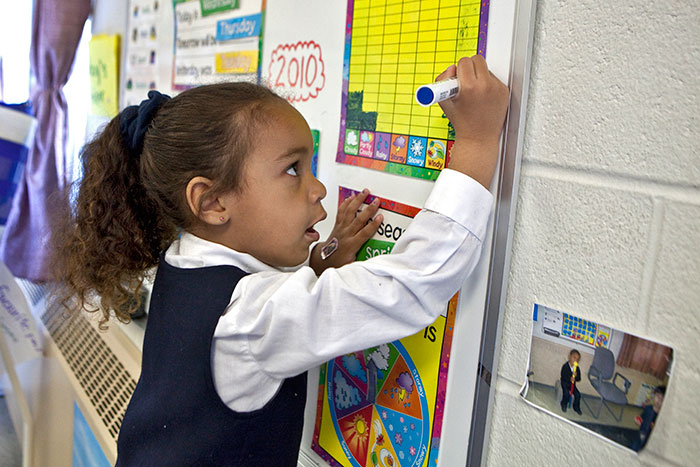
Relationship-driven classes
Each class is viewed as a system of relationships. Teachers consider each child’s relation to their family, other children, the teachers, the school environment, the community, and wider society.
The Reggio Emilia classroom is set up for lots of interaction. Children interact with teachers throughout the day, and they often work with their peers in small groups of two to five. They also sometimes work in class with parents and other members of the community.
It’s believed that children learn well through social interaction. In particular, they learn effectively by working with peers. This allows them to listen to each other, ask and answer questions, and solve problems together. It also nurtures their curiosity and imagination, and improves their social skills. The result is a fun and dynamic classroom.
“Teachers respect parents as a child’s first teacher, and involve them in many different aspects of school.”
Different modes of learning
Teachers create environments where children can use many modes or languages to learn (Malaguzzi referred to these as the “hundred languages.”) These modes include drawing, painting, modelling, sculpting, music, dance, poems, stories, metaphors, and more. Children are also given a wide range of materials to express themselves, such as paint, clay, wire, and natural and recycled materials.
In fact, there isn’t a sharp separation between expressing oneself through words (directly) and through art. All are considered part of the language of learning. Also, in Reggio preschool, there isn’t a sharp separation between art and play.
Encouraging children to express themselves in lots of ways, it’s claimed, has several benefits. For starters, it encourages children to use many of their senses and abilities. It also promotes open communication and allows children to express complex thoughts and feelings. And, it allows children and teachers (and parents) to better understand each other.
Parent involvement
Parents are a vital part of education. They’re viewed as partners with and advocates for children. Teachers respect parents as a child’s first teacher, and involve them in many different aspects of school.
In fact, parents are encouraged to be active in school. This can take many forms, including day-to-day interaction, advising, work in the schools, field trips, and celebrations. Moreover, many parents incorporate Reggio principles in their home.
“Normally,” says Susan Lyon, executive director of the Innovative Teacher Project, “parents are not seen as part of the educational process in an authentic way.” Reggio schools, on the other hand, view parents as an important part of children’s learning, and educators support them in this role.
“Reggio-inspired schools have a mostly self-guided curriculum. Teachers listen to and observe children in the classroom to discover what interests and excites them.”
4 | Reggio Emilia classroom |
Reggio-inspired schools aim to produce the ideal environment for children. Plenty of attention is given to the look and feel of the classroom. So much so that it’s often referred to as the “third teacher.”
The Reggio Emilia classroom is warm and welcoming. It promotes open communication, interaction, and relationships. It also fosters active learning and problem-solving.
Moreover, as G.S. Morrison points out (“Reggio Emilia,” 2010), classrooms are carefully and aesthetically arranged:
“There is attention to detail everywhere: in the colour of the walls, the shape of the furniture, the arrangement of simple objects on shelves and tables. Light from the windows and doors shines through transparent collages and weavings made by children. Healthy green plants are everywhere. Behind the shelves displaying shells or other found or made objects are mirrors that reflect the patterns that children and teachers have created.”
The Reggio Emilia classroom is also personal. For instance, small boxes made of white cardboard are placed on the wall. The name of a child or teacher is printed on each box. The boxes are used to leave little messages and surprises for each other. This promotes the sharing of thoughts and feelings.
Finally, the classroom is full of children’s work. Everywhere are paintings, drawings, sculptures, collages, mobiles, and more. Although this display is pleasing, it’s not mere decoration. As G.S. Morrison points out (2010), it’s meant “to show and document the competence of children, the beauty of their ideas, and the complexity of their learning process.”
Most schools have a special workshop or studio, called an “atelier,” separate from the main classroom. It’s used by all the children and teachers in the school. It contains many tools and resources, and records of past work. Some schools also have smaller spaces, called “mini-ateliers.”
Just as there isn’t a strict Reggio curriculum, there also aren’t required learning materials. Different schools tend to use different materials.
In general, though, lots of open-ended materials are provided, which can be used in a variety of ways. This is meant to promote curiosity, problem-solving, and discovery-based learning. This aim is similar to that of other play-based schools and preschools. Materials are also chosen for their beauty.
Although no material is required, many materials can be and are used in Reggio schools. According to Reggio Emilia Approach, a list of such materials includes the following:
To learn more about Reggio Emilia learning materials, check out the learning materials workshop.
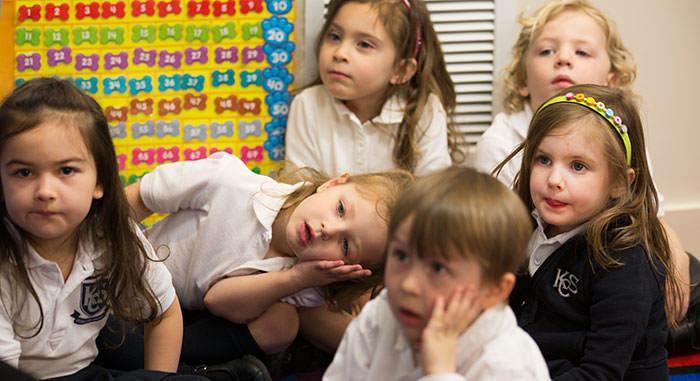
Teachers rarely lecture. Instead, they connect children with meaningful tasks. Normally, they plan lessons and activities based on children’s interests. They also take part in these activities, instead of just watching. This can nurture a child’s curiosity and engagement.
Often, teachers listen to and observe children in the classroom. They also record what they observe. This helps them plan the curriculum with children’s interests in mind. It also helps them prepare the environment and teaching tools.
That said, while children influence the curriculum, there’s an age-appropriate daily schedule. This ensures children achieve developmental goals. This is similar to Waldorf schools and preschools.
Teachers partner with colleagues, students, and parents in the learning process. For instance, they discuss their observations with them, as part of an ongoing dialogue. This allows them to be flexible in their plans, preparations, and teaching approaches.
Lella Gandini is a professor of early education and child study at the University of Massachusetts in Amherst. She’s known as the leading advocate for the Reggio Emilia approach in the United States. In a recent interview (2011), she nicely describes the role of collaboration in the work of a Reggio teacher:
“Teachers in Reggio Emilia work together and are supported by pedagogical coordinators; they all share and start from the basic principle that children have great potential and desire to explore, construct, and learn. … It is amazing what observations and also conversations with children can tell us educators about the complexity and beauty of their theories. … On the basis of what the children do and say, the teachers can offer them the possibilities to explore further and learn more.”
Teachers plan projects and help kids put together portfolios of their work. They also display children’s work throughout the classroom. This enables Reggio kids to gauge their own progress. It also makes them aware that their effort is valued. And, it helps parents stay in touch with what’s going on in class.
Atelieristas, teachers trained in the visual arts, also play a key role. These teachers work closely with children in a studio, separate from the classroom. Like the core teachers, they connect children with meaningful projects. They also make visits to the main classroom.
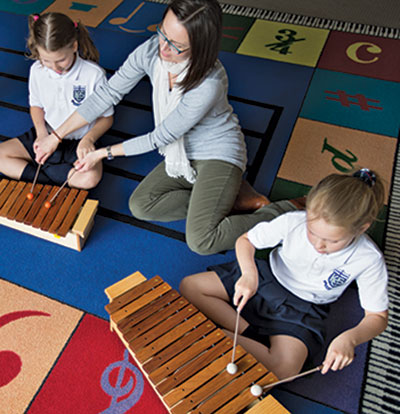
5 | The Reggio Emilia appeal |
The Reggio Emilia approach was developed for use in preschool, kindergarten, and daycare. It’s now sometimes adapted to meet the needs of elementary school students. Reggio influences can be found in schools across Canada, including in The Bishop Strachan School, Richland Academy, Urban Academy, and Vinci School.
Marlina Oliveira and Laura Murgatroyd of Richland Academy explain that with Reggio Emilia “it starts as a mindset of how we view children; we see how capable they are, and how creative they are.”
With the Reggio approach, kids aren’t held back by what teachers know. Kids take an active part in the learning process:
“Sometimes, children are only taught what we know. We don’t limit them—we listen to them, there’s a lot of intentional listening, and really co-constructing what that learning looks like,” say Oliveira and Murgatroyd.
Being listened to and co-constructing their learning inspires Reggio kids to be active in the learning process. According to Dr. Dan Yang, a teacher at VINCI School, Reggio Emilia’s focus on the child as an engaged learner, rather than as a receptacle of facts and information, is critical now, more than ever.
“Today in the 21st century, it’s no longer an environment where it’s enough for students to remember facts. … Today, knowledge itself doesn’t work too much anymore, because anything you need to know you just Google it. You watch YouTube, you do an Internet search, and you get it. So, remembering facts should no longer be the centre of education anymore,” she explains.
Not only does the Reggio Emilia approach lend itself to 21st century learning, it also focuses on promoting higher-order thinking and critical analysis at a young age.
“We’re looking at helping children to cultivate those higher-order thinking skills,” says Yang, “such as analysis, synthesizing, and coming up with their own solutions. Reggio Emilia is very important in terms of supporting children to gradually build that higher-order thinking skill because young children who are five and six years old, their thoughts are still very fragmented. It’s a dotted, not a connected line.”
“We need to help children to do that abstract thinking to begin with, and then gradually help them to have that habit to always think ahead, so they can learn to believe not only in what they see, but in what they don’t see, because that’s the analysis and the synthesizing skills that we’re talking about.”
The Reggio Emilia approach continues to excite and motivate children. Its self-guided curriculum helps children learn key skills, including critical thinking, logical analysis, and problem-solving. To be sure, this promises to help children thrive, in the school years and beyond.
Private Reggio Emilia schools tend to be reasonably priced. They’re typically on the lower side of private school tuition in general. Of course, the cost of a school will vary based on size, location, the level of schooling, and other factors. Typically, though, it ranges from $5,000 to $20,000 per year.
Moreover, some schools offer financial support to defray costs. For instance, if you can demonstrate need, they might offer you a bursary to help finance your child’s education. Or if your child excels in some area, such as academics, they might be awarded a scholarship to help cover tuition. Typically, more bursaries are offered than scholarships.
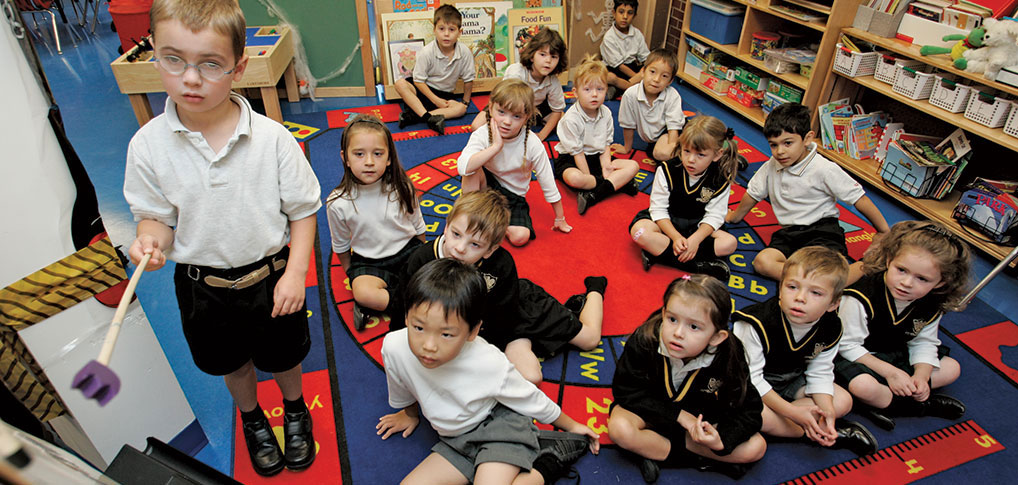
6 | Compare Reggio Emilia schools |
Primary curriculum | Secondary curriculum | Curriculum pace | Academic culture | Average class size | Language immersion | Special needs support | Tech integration |
|
|---|---|---|---|---|---|---|---|---|
St. Mildred's-Lightbourn School | Progressive | Reggio Emilia | Standard-enriched | Rigorous | No support | |||
Hudson College | Traditional | Reggio Emilia | Standard-enriched | Rigorous | 15 to 22 | No support | Medium integration | |
Kingsway College School | Progressive | Standard-enriched | Rigorous | 20 to 22 | No support | Medium integration | ||
Bayview Glen | Traditional | Accelerated | Rigorous | 20 to 22 | No support | |||
Balmoral Hall School | Progressive | International Baccalaureate | Accelerated | Supportive | 10 to 20 | Resource Assistance | Heavy integration | |
The Bishop Strachan School | Progressive | Reggio Emilia | Standard-enriched | Rigorous | 18 to 22 | No support | Heavy integration | |
St. Michaels University School | Progressive | Standard-enriched | Rigorous | No support | Medium integration | |||
Richland Academy | Progressive | International Baccalaureate | Standard-enriched | Rigorous | 15 to 20 | Resource Assistance | Medium integration | |
Oak Learners | Progressive | Reggio Emilia | Student-paced | Supportive | 6 to 8 | Indirect Support | Medium integration | |
Vincent Massey Academy | Progressive | Student-paced | Supportive | 13 to 15 | No support | Light integration | ||
Children's Garden Nursery School | Traditional | Reggio Emilia | Student-paced | Supportive | 8 to 10 | Indirect Support | Light integration | |
Summit Micro School | Progressive | Reggio Emilia | Student-paced | Supportive | 6 to 12 | Withdrawal Assistance | Medium integration | |
St. John's-Ravenscourt School | Liberal Arts | Reggio Emilia | Standard-enriched | Rigorous | 18 to 24 | No support | Heavy integration | |
Pythagoras Academy | Traditional | Reggio Emilia | Accelerated | 8 to 15 | No support | Medium integration | ||
CGS (Children's Garden School) | Traditional | Reggio Emilia | Accelerated | Supportive | 8 to 24 | Withdrawal Assistance | Light integration | |
Kingsley Primary School | Traditional | Reggio Emilia | Student-paced | Supportive | No support | Medium integration | ||
Pickering College | Progressive | Standard-enriched | Rigorous | 18 to 20 | No support | Heavy integration | ||
Collingwood School | Progressive | Standard-enriched | Supportive | 16 to 22 | No support | Heavy integration | ||
AIM Without Limits | Traditional | Reggio Emilia | Student-paced | Supportive | 5 to 8 | Special needs school | Medium integration | |
Sunflower Early Learning Society | Reggio Emilia | Student-paced | Supportive | 5 to 15 | Resource Assistance |
| Tuition (day school) | Students receiving financial aid | Grade eligibility for financial aid | Avg. aid package size (annual) | |
|---|---|---|---|---|
St. Mildred's-Lightbourn School | $25,180 to $32,310 | 9% | ||
Hudson College | $19,000 to $21,500 | 8% | 7 - 12 | $5,600 |
Bayview Glen | $20,950 to $31,050 | 6 - 12 | $5,000 | |
Balmoral Hall School | $15,450 to $19,210 | 15% | SK - 12 | $8,333 |
The Bishop Strachan School | $35,800 | 10% | 7 - 12 | $21,000 |
St. Michaels University School | $21,095 to $43,995 | 20% | K - 12 | $11,685 |
St. John's-Ravenscourt School | $27,960 to $28,590 | 10% | 6 - 12 | $15,000 |
Kingsley Primary School | $12,000 | 5% | Preschool - 5 | $5,000 |
Pickering College | $34,700 | |||
Collingwood School | $23,800 to $28,150 | 2% | 6 - 12 | $7,500 |
AIM Without Limits | $19,000 |
7 | Important resources |
To discuss Reggio Emilia education, visit our parent discussion forum.
To learn more about Reggio Emilia education, check out the following websites and articles: